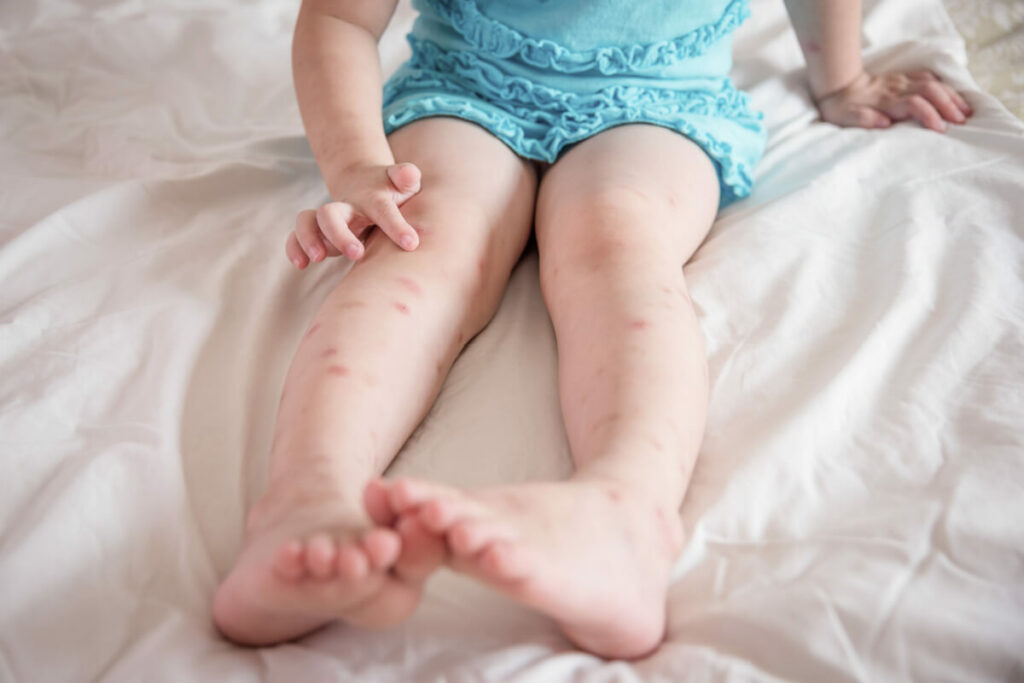Whether camping, lounging at the beach, or going for a hike, pesky insects always seem to be nearby. Some just buzz in your ear, while others consider you a meal. Bugs like mosquitoes, sand flies, and ticks obtain a blood meal by biting humans and animals. (17) Often, these bug bites are not severe, only leaving an itchy raised bump; however, excessive scratching can lead to infection. Biting insects may also cause a more serious allergic reaction or even spread diseases to humans. (14)
Fortunately, there are many natural remedies to combat the itch. Keep reading below for natural bug bite relief and ways to prevent bug bites in the future.
Why do bug bites itch?
Mosquitos and similar biting insects use a special mouthpart creating a small hole to suck up blood from their chosen host. Mosquito bites are often not detected while the mosquito is feeding but later when noticing a small itchy bump. This skin irritation is an immune response to the insects’ saliva, which is injected into the skin as the bug bites. (3)(17)
5 natural remedies for itchy bug bites
Most bug bites resolve on their own within a few days, but they can be overwhelmingly itchy in the meantime. (14) It’s best to refrain from scratching as much as possible while the bug bite is healing to reduce inflammation and the risk of infection. (3) To help reduce itching and skin irritation, wash the bug bite with soap and water and consider the following evidence-based anti-itch home remedies.

1. Baking soda
In cases of inflammation, the immune system requires more energy than usual to heal the affected area. This can impact the acid-base balance in the area, making inflamed areas more acidic than usual. This acidity attracts immune cells and further stimulates inflammation. (18) Baking soda (sodium bicarbonate) has a basic pH, which may have soothing properties by neutralizing the area and relieving itching. (3)
Create a baking soda paste by mixing one part baking soda with three parts water. Apply the baking soda paste to the bug bite and let it sit for about 10 minutes. Gently rinse off the baking soda and feel relief from your itchy bite. (3)
2. Cold therapy
Cold therapy is a common natural remedy for bug bites. Cold application lowers skin temperature and decreases swelling and nerve activity to reduce pain. (11) Soothe itchiness with cold therapy by applying an ice cube, ice pack, or cold water to irritated skin. Products that provide a cooling sensation, such as peppermint oil, may also have similar effects. (12)
3. Colloidal oatmeal
Finely ground oats (Avena sativa), referred to as colloidal oatmeal, may relieve itching due to its anti-inflammatory and antioxidant properties. (19) Try taking a cool oatmeal bath or using oatmeal-containing skincare products to help relieve itchy bug bites.

4. Tea tree oil
Tea tree oil is an essential oil distilled from the leaves of the Australian tea tree. Research demonstrates the plant’s antibacterial and anti-inflammatory properties, which may help relieve itchy bites. As an essential oil, tea tree oil shouldn’t be applied to the skin without a carrier oil. (2) If an allergic reaction or skin irritation occurs, gently wash the area and discontinue use immediately.
Did you know? Carrier oils, such as aloe vera gel, avocado oil, or jojoba oil, can dilute essential oils and support skin absorption. (16)
5. Witch hazel
Witch hazel is a natural astringent, a drying substance that tightens the skin. Witch hazel is also rich in certain antioxidant compounds that have antibacterial and anti-inflammatory properties. (21) Gently dab witch hazel on mosquito bites with a cotton ball to try this natural remedy. If you don’t have witch hazel at home, applying apple cider vinegar or cold green tea bags may have similar effects, demonstrating astringent properties. (13)(22)
Bug bite precautions
Everyone’s immune system reacts differently to mosquito bites and other bug bites. Some individuals develop a mild skin irritation, while a large area of swelling or other signs of an allergic reaction may appear for others. Certain insects also carry diseases, which can spread to humans from the bite. (3)
Infection
Scratching insect bites can spread bacteria and cause an infection. An infected bite may appear very red, feel warm and tender, or ooze fluid. Consult with your integrative healthcare provider if a bug bite becomes infected. (3)(6)
Serious allergic reaction
Severe allergic reactions to bug bites can be life-threatening. Exposure to a new mosquito species, being a child, or having an immune system disorder may lead to a more serious reaction. Signs of an allergic reaction include:
- A large area of swelling and redness
- Blistering
- Low-grade fever
- Hives
- Swollen joints
- Swollen lymph nodes (1)(3)
Many individuals can relieve the symptoms of an allergic reaction at home; however, if swelling persists or the area doesn’t seem to improve, contact your healthcare provider as soon as possible. (1)
Select individuals may experience anaphylaxis due to a bug bite, a potentially life-threatening condition. (14) Signs of anaphylaxis include:
- Feeling weak
- Severe swelling on the face or in the mouth
- Throat tightness or difficulty swallowing
- Trouble breathing, wheezing, or shortness of breath
- Turning blue (15)
Seek emergency medical attention if an anaphylactic reaction occurs.

Disease
Certain biting insects, such as mosquitos or ticks, can spread diseases to humans and animals. Many of these diseases don’t have a cure and can’t be prevented.
Mosquitoes
About 12 out of the 200 mosquito species in North America are capable of spreading diseases such as malaria and West Nile virus. (4)(14) Mosquito transmission of the Zika virus has also been reported in the United States, including in Florida and Texas. However, since 2018 there have been no new confirmed cases of Zika virus in the United States. (10)
Ticks
The black-legged tick is another disease-spreading insect that bites and attaches to the human body to feed on blood slowly for several days. Ticks are tiny, ranging from the size of a poppy seed to a sesame seed, and mainly attach to the body in hard-to-see areas such as the armpits, groin, or scalp. (5) Ticks infected with the bacterium Borrelia burgdorferi can spread Lyme disease, the most common insect-spread disease in North America. (7)
After spending time in brushy or wooded areas, always check your body, clothing, gear, and pets for ticks. If you spot a tick, immediately remove it. If a tick has bitten you or you develop a rash or fever within the following weeks of tick exposure, seek medical attention as soon as possible. (9)
Did you know? Preventing bug bites is the best way to avoid getting sick from one. When spending time outdoors, try to protect yourself from bug bites by:
- Using insect repellent
- Covering your skin with long-sleeved shirts, long pants, and long socks (8)
- Removing standing water (where mosquitoes breed)
- Using screens or netting to keep biting insects out of your home (14)
The bottom line
For many people, the worst part about a bug bite is the itch. Anti-itch natural remedies, such as an ice pack or baking soda, may provide instant relief. It’s best to avoid scratching insect bites, as excessive scratching may cause the bite to become infected. Bug bites can also lead to other complications, including illness or a severe allergic reaction. Try to protect yourself from insect bites in the future with insect repellent and skin-covering clothes.
- American Academy of Allergy Asthma & Immunology. (2020). Mosquito bite reactions. https://www.aaaai.org/tools-for-the-public/conditions-library/allergies/taking-a-bite-out-of-mosquitoes
- Carson, C. F., Hammer, K. A., & Riley, T. V. (2006). Melaleuca alternifolia (tea tree) oil: a review of antimicrobial and other medicinal properties. Clinical microbiology reviews, 19(1), 50–62.
- Centers for Disease Control and Prevention. (2020a). Mosquito bite symptoms and treatment. https://www.cdc.gov/mosquitoes/about/about-mosquito-bites.html
- Centers for Disease Control and Prevention. (2020b). Mosquitoes in the US. https://www.cdc.gov/mosquitoes/about/about-mosquitoes-in-the-united-states.html
- Centers for Disease Control and Prevention. (2020c). Transmission of Lyme disease. https://www.cdc.gov/lyme/causes/index.html
- Centers for Disease Control and Prevention. (2021). Know the signs and symptoms of infection. https://www.cdc.gov/cancer-preventing-infections/index.html
- Centers for Disease Control and Prevention. (2022a). Lyme disease. https://www.cdc.gov/lyme/index.html
- Centers for Disease Control and Prevention. (2022b). Prevent mosquito bites. https://www.cdc.gov/mosquitoes/prevention/index.html
- Centers for Disease Control and Prevention. (2022c). Tick removal. https://www.cdc.gov/ticks/after-a-tick-bite/index.html
- Centers for Disease Control and Prevention. (2022d). Zika travel information. https://wwwnc.cdc.gov/travel/page/zika-information
- Hermann J. (2009). Kryotherapie . Zeitschrift fur Rheumatologie, 68(7), 539–541.
- Liu, B., & Jordt, S. E. (2018). Cooling the itch via TRPM8. The Journal of investigative dermatology, 138(6), 1254–1256.
- Korać, R. R., & Khambholja, K. M. (2011). Potential of herbs in skin protection from ultraviolet radiation. Pharmacognosy reviews, 5(10), 164–173.
- National Institutes of Health. (2017). Mosquito bites. MedlinePlus. https://medlineplus.gov/mosquitobites.html
- National Institutes of Health. (2021). Insect bites and stings. MedlinePlus. https://medlineplus.gov/ency/article/000033.htm
- Orchard, A., Kamatou, G., Viljoen, A. M., Patel, N., Mawela, P., & van Vuuren, S. F. (2019). The Influence of carrier oils on the antimicrobial activity and cytotoxicity of essential oils. Evidence-based complementary and alternative medicine: eCAM, 2019, 6981305.
- Powers, J., & McDowell, R. H. (2022). Insect Bites. In StatPearls. StatPearls Publishing.
- Rajamäki, K., Nordström, T., Nurmi, K., Åkerman, K. E., Kovanen, P. T., Öörni, K., & Eklund, K. K. (2013). Extracellular acidosis is a novel danger signal alerting innate immunity via the NLRP3 inflammasome. The Journal of biological chemistry, 288(19), 13410–13419.
- Reynertson, K. A., Garay, M., Nebus, J., Chon, S., Kaur, S., Mahmood, K., Kizoulis, M., & Southall, M. D. (2015). Anti-inflammatory activities of colloidal oatmeal (Avena sativa) contribute to the effectiveness of oats in treatment of itch associated with dry, irritated skin. Journal of drugs in dermatology: JDD, 14(1), 43–48.
- Seda, J., & Horrall, S. (2022). Mosquito Bites. In StatPearls. StatPearls Publishing.
- Thring, T. S., Hili, P., & Naughton, D. P. (2011). Antioxidant and potential anti-inflammatory activity of extracts and formulations of white tea, rose, and witch hazel on primary human dermal fibroblast cells. Journal of inflammation (London, England), 8(1), 27.
- Yagnik, D., Serafin, V., & J Shah, A. (2018). Antimicrobial activity of apple cider vinegar against Escherichia coli, Staphylococcus aureus and Candida albicans; downregulating cytokine and microbial protein expression. Scientific reports, 8(1), 1732.





